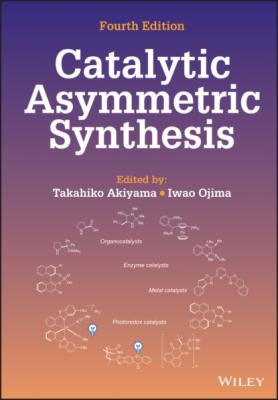Catalytic Asymmetric Synthesis. Группа авторов
Чтение книги онлайн.
Читать онлайн книгу Catalytic Asymmetric Synthesis - Группа авторов страница 29
 Shibata, Department of Chemistry and Biochemistry, Faculty of Science and Engineering, Waseda University, Tokyo, Japan
Shibata, Department of Chemistry and Biochemistry, Faculty of Science and Engineering, Waseda University, Tokyo, Japan
Brian M. Stoltz, California Institute of Technology, Pasadena, CA, USA
Bin Tan, Department of Chemistry, Southern University of Science and Technology, Shenzhen, China
Ken Tanaka, Department of Chemical Science and Engineering, Tokyo Institute of Technology, Tokyo, Japan
Masahiro Terada, Graduate School of Science, Tohoku University, Sendai, Japan
F. Dean Toste, University of California, Berkeley, Berkeley, CA, USA
Muhammet Uyanik, Graduate School of Engineering, Nagoya University, Nagoya, Japan
Xavier Verdaguer, Departament de Química Inorgànica i Orgànica, Facultat de Química, Universitat de Barcelona, Barcelona, Spain and Institute for Research in Biomedicine (IRB Barcelona), The Barcelona Institute of Science and Technology (BIST), Barcelona, Spain
Anton Vidal‐Ferran, Departament de Química Inorgànica i Orgànica, Facultat de Química, Universitat de Barcelona, Barcelona, Spain and Catalan Institution for Research and Advanced Studies (ICREA), Barcelona, Spain and Institut de Nanociència i Nanotecnologia (IN2UB), Universitat de Barcelona, Barcelona, Spain
Hongling Wang, Laboratory Breeding Base of Green Pesticide and Agricultural Bioengineering, Key Laboratory of Green Pesticide and Agricultural Bioengineering, Ministry of Education, Guizhou University, Guiyang, China
Tomasz Wdowik, Institut für Organische und Biomolekulare Chemie, Georg‐August‐Universität Göttingen, Göttingen, Germany
Thomas Hin‐Fung Wong, ICIQ – Institute of Chemical Research of Catalonia, Tarragona, Spain
Shaohua Xiang, Department of Chemistry, Southern University of Science and Technology, Shenzhen, China
Jia‐Lei Yan, Division of Chemistry and Biological Chemistry, School of Physical and Mathematical Sciences, Nanyang Technological University, Singapore, Singapore
Xiao Zhang, Department of Chemistry, Columbia University, New York, NY, USA
1 ASYMMETRIC ENAMINE AND IMINIUM ION CATALYSIS
Yujiro Hayashi
Department of Chemistry, Graduate School of Science, Tohoku University, Sendai, Japan
1.1. INTRODUCTION
Enamines are key reactive species in many asymmetric organocatalytic reactions. The field of asymmetric catalytic reactions involving an enamine as a reactive intermediate dates back to the seminal work in the 1970s on proline‐mediated intramolecular aldol reaction of triketone reported by Hajos and Parrish at Hoffmann‐La Roche [1] and Eder, Sauer, and Wiechert at Schering AG [2] (Eq. 1.1). In 2000, List, Lerner, and Barbas reported a proline‐mediated intermolecular aldol reaction (Eq. 1.2) [3], in which enamine is a key intermediate. In the same year, MacMillan reported a Diels‐Alder reaction catalyzed by a chiral imidazolidinone via an iminium ion as a reactive intermediate (Eq. 1.3) [4]. In these reactions, small organic molecules catalyze reactions enantioselectively. Since these discoveries, chemistry based on organocatalysts involving an enamine and an iminium ion as an intermediate has developed dramatically [5]. There are several advantages to performing reactions with organocatalysts: (i) exclusion of water and air is not necessary, (ii) the product is free from metal contamination, (iii) most of the organocatalysts are nontoxic, (iv) most reactions do not need low temperature or high temperature, and (v) it is easy to carry out the reaction on a large scale. Given these merits, many catalysts and reactions have been developed. In the previous book of this series published in 2010 [6], progress in the field of organocatalysis is nicely summarized up to 2010. In this chapter, a brief introduction to enamine and iminium ion species will be presented, including work before 2010, and more recent developments in this field will be expanded. Reactions using a combination of organocatalyst and photocatalyst, which have been developed recently, will be described in Chapter 9 of this book.
1.2. REPRESENTATIVE ORGANOCATALYSTS
1.2.1. Introduction
Enamines are generated from aldehydes or ketones upon reaction with secondary or primary amines, and the enamine can react with an electrophile to give an α‐functionalized derivative of the carbonyl compounds (Eq. 1.4).
α,β‐Unsaturated aldehydes or ketones also react with secondary or primary amines to generate an iminium ion, which has lower LUMO (lowest unoccupied molecular orbital) level compared with the parent α,β‐unsaturated carbonyl compound. A nucleophile reacts with the iminium ion to afford a β‐functionalized derivative of the carbonyl compound (Eq. 1.5).
Enamine and iminium ions are reactive species and many reactions involving these intermediates have been developed. Representative organocatalysts that have been used to generate enamines and iminium ions are presented in Figure 1.1.
Proline is a secondary amine catalyst that was first used in the intramolecular aldol reaction in the 1970s (Eq. 1.1). It is a bifunctional catalyst, possessing an amine moiety and an acid moiety (carboxylic acid) vide infra [3]. Imidazolidinone catalyst, which was developed by MacMillan, is a secondary amine catalyst prepared from phenylalanine [4]. Diarylprolinol silyl ether [7], which was developed by Jørgensen [8] and Hayashi [9] independently